Understanding the Navadurga through the spiritual canvas of Bapu's Bhav-vishwa (devotional realm) - Part 8
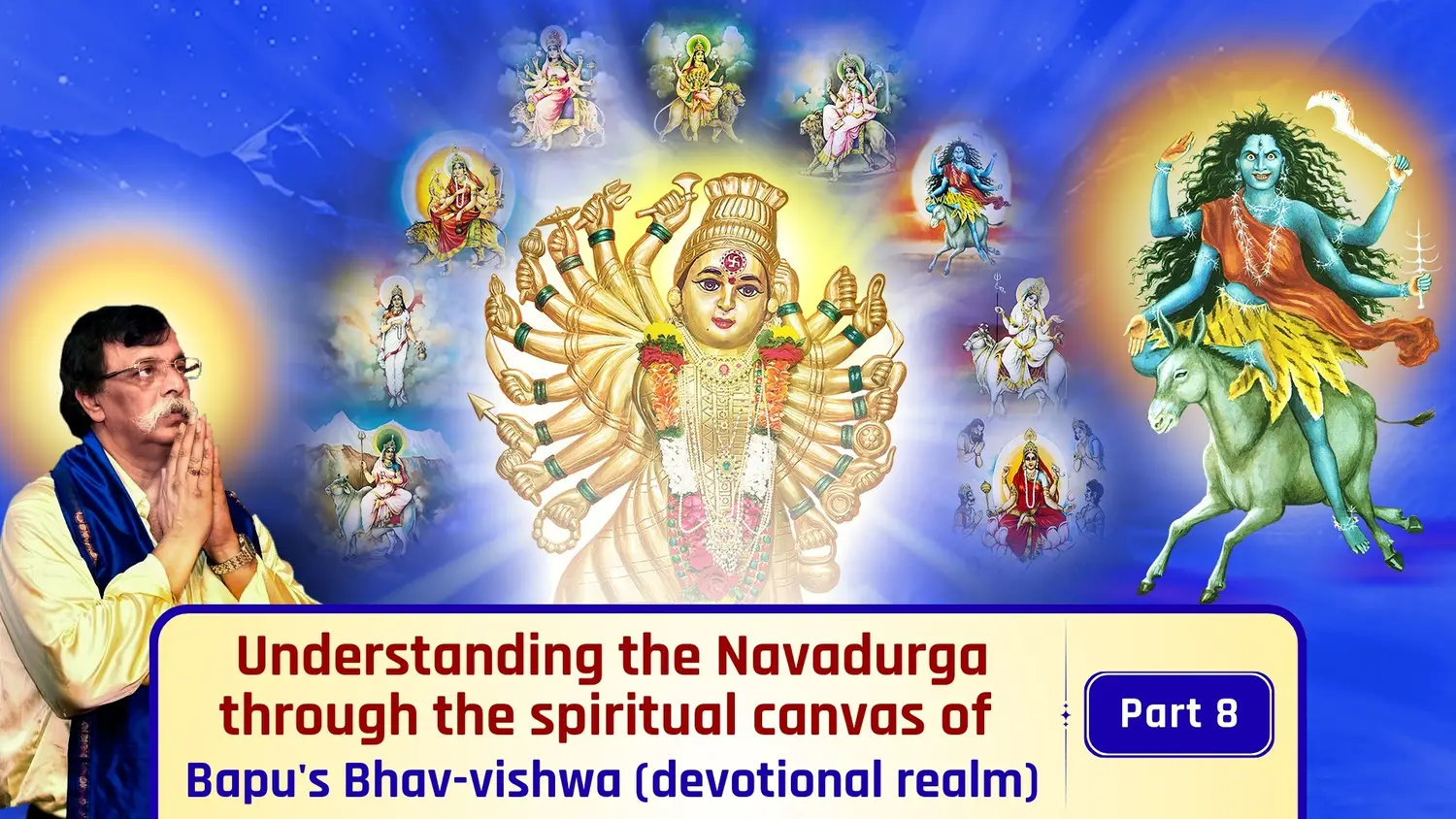
Reference: From the editorials numbered 1394 and 1395 in the Tulsipatra series of the daily ‘Pratyaksha’ by Sadguru Shree Aniruddha Bapu.
In Tulsipatra – 1394, Sadguru Shree Aniruddha Bapu writes:
Brahmavadini Lopamudra bowed at the lotus feet of the seventh Navadurga, Kalaratri, offered her humble salutations, and began to speak, “Dear ones, this seventh Navadurga, Kalaratri, is the presiding deity of the thirteenth and fourteenth steps of the Shambhavi Vidya and is the presiding deity of the day and night of Ashwin Shuddha Saptami. This goddess Kalaratri completely destroys the enemies of the devotees. Because of her worship, ghosts, spirits, demons, devils, Tamachari mantriks, and sinful enemies cannot even come near the devotee for an entire year.”
All the Shivaganas looked at each other in confusion and said, “But we ourselves belong to the realm of spirits, and yet, instead of feeling afraid of her, we feel great affection towards her.”
Smiling, Lopamudra replied, “She is indeed like that, and you are ‘Shivaganas,’ not merely spirits. Moreover, your forms have also transformed now.”
All the sages stood up and requested Lopamudra with folded hands, “We have to travel alone through forests, dense jungles, cremation grounds, and ancient battlefields where terrible wars once took place. After hearing about her glory, we too wish to bow our heads at the lotus feet of this seventh Navadurga, Kalaratri. Will we be granted such permission?”
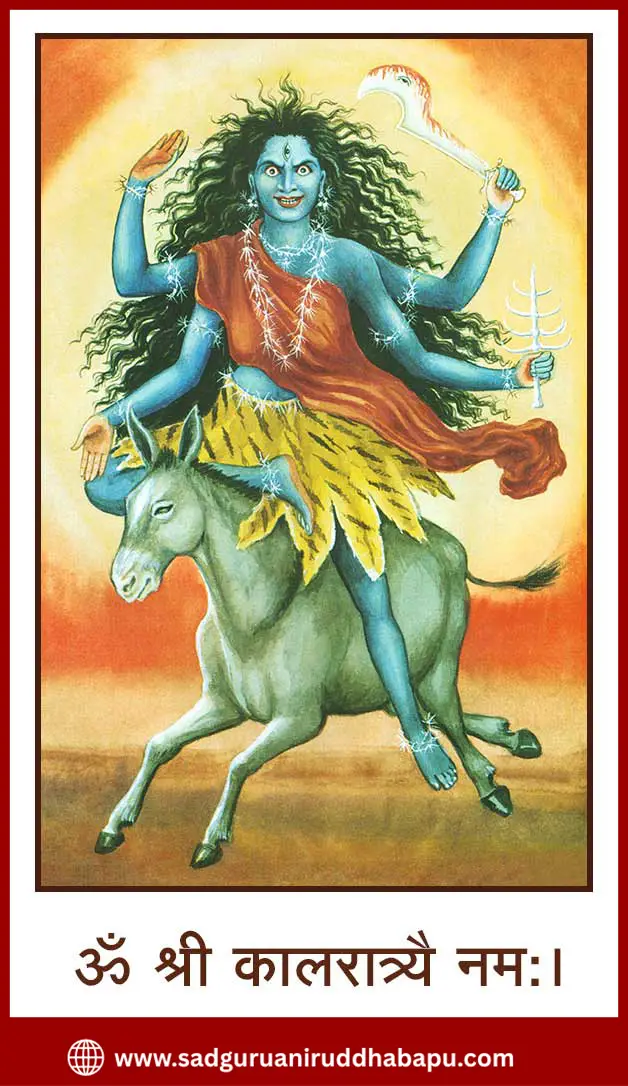
Brahmavadini Lopamudra looked questioningly at Bhagwan Trivikram. With his mother’s consent, Bhagwan Trivikram once again appeared among them in his one-faced form and asked Brahmavadini Arundhati to hold Lopamudra’s hands and show them to everyone. He also told her to remove the cloth covering Lopamudra’s head so that all could see it.
When Arundhati did so, all the sages, seers, and young ascetics were astonished and slightly afraid.
Wherever the lotus feet of Goddess Kalaratri had touched Lopamudra’s head and hands, lightning sparks had entered into her Sahasrarchakra, flashing and playing about. From her hands, waves of fire entered all seventy-two thousand nerves in her body, dancing within them in bliss.
Seeing this, even the great sages were afraid. Then Bhagwan Trivikram said, “This is the nature of Kalaratri. These flames and lightning rays do not cause Lopamudra any pain or suffering. On the contrary, they awaken all the powers within her Sahasrarchakra, and the one hundred and eight power centers in her body have turned into sacred Yadnyakund. Such radiance cannot be borne, not only by an ordinary human but even by Maharshis.
The eighth Navadurga, Mahagauri, even though her form is peaceful and serene, when her feet touch the human body, all one hundred and eight power centers become extremely calm and cool. The seventy-two thousand nerves begin to flow with lunar energy like streams of cool light, and even that cooling effect cannot be easily endured by ordinary Shraddhavans or even by Maharshis.
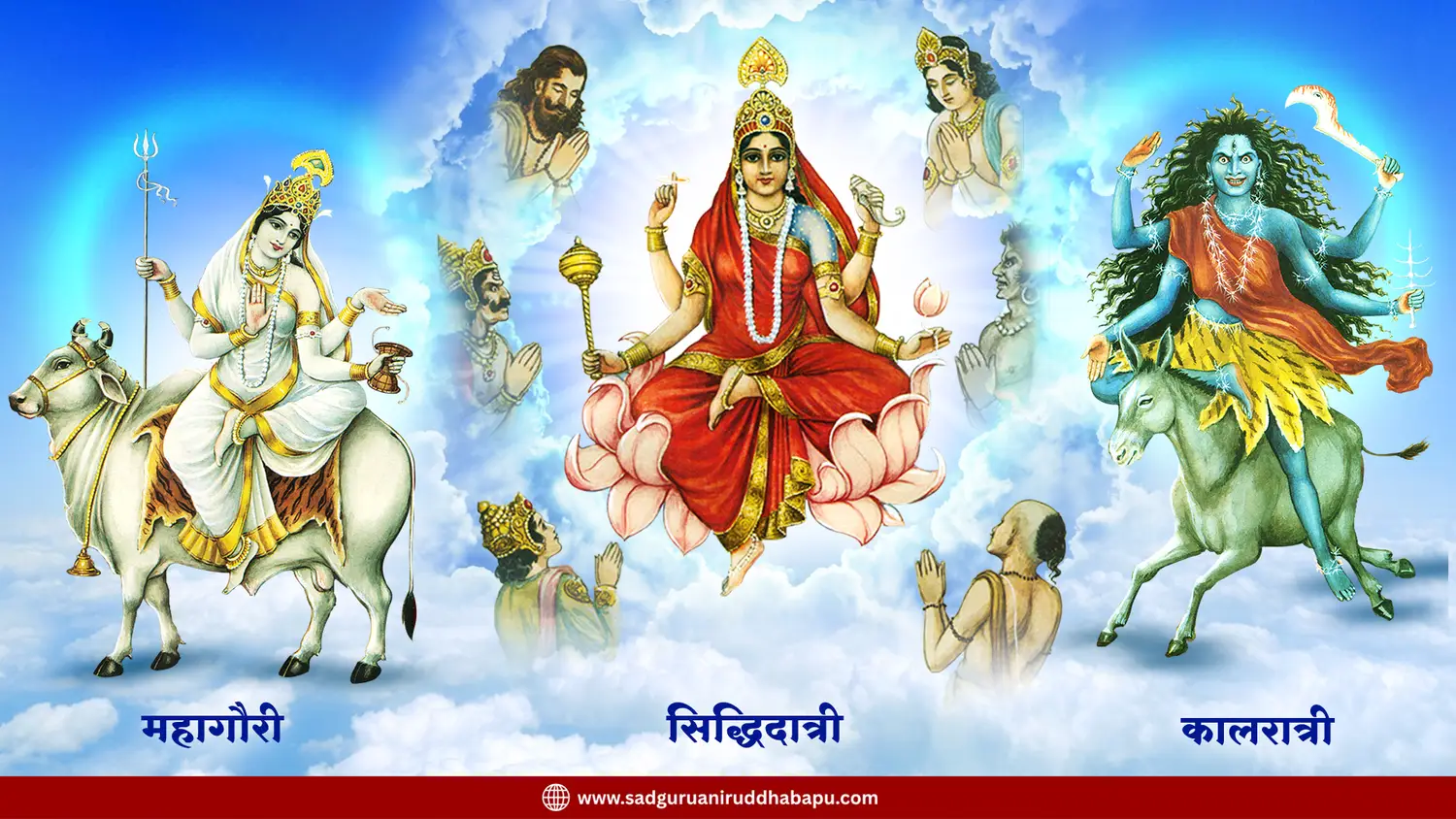
The ninth Navadurga, Siddhidatri, has a blissful and gentle expression, but she is one with the Mother who resides in Manidweepa. Because of this, though it is easy to worship the idols of these three goddesses, meditating upon their real forms is difficult even for Maharshis.
However, the fruits of directly worshipping or meditating upon these three can easily be attained by worshipping Mother Lalitambika on the fifth day of the Ashwin Shuddha Navaratri. The presiding deity of the fifth day is Skandamata, and Lalitambika is truly the great grandmother of all Shraddhavans.
This Adimata, in the form of Lalitambika, manifests every year on the day of ‘Lalitapanchami.’ On that day, Kalaratri, Mahagauri, and Siddhidatri act as her chief commanders. Describing the method of worship for Lalitapanchami would take me several days.”
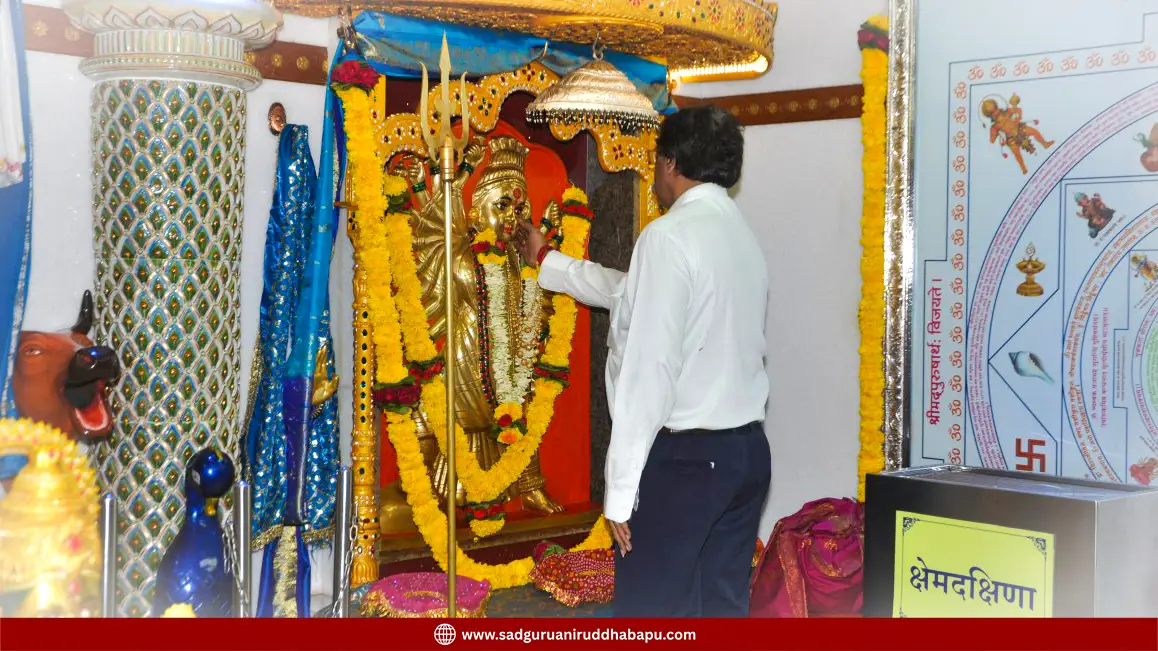
After saying this, Bhagwan Trivikram bowed to Kalaratri and to the Adimata. Immediately, all nine Navadurgas, the ten Mahavidyas, the seven divine mothers, and sixty-four crore Chamundas appeared there.
Then all of them, one by one, entered into every pore of the body of the Adimata, Mahishasuramardini.
From the third eye of the Manidweepnivasini (who dwells in the Manidweep) Adimata, a unique brilliance spread everywhere—both intense and gentle at once. As this radiance spread, the form of the Primordial Mother began to transform, and her form as Lalitambika became visible.
As soon as Lalitambika manifested, she assured everyone, “Whether a person is able to perform the Navaratri poojan on other days of Navratri or a person is not able to perform the Navaratri poojan on other days of Navratri, on the day of Lalitapanchami, by worshipping me in my form as Mahishasuramardini together with my beloved son, one attains the full fruit of the entire Navaratri according to one’s devotion.
The same blessings that are gained by bowing at the lotus feet of Kalaratri, Mahagauri, and Siddhidatri can be received in a gentler way simply by offering Bilva leaves to me and Trivikram on the day of Lalitapanchami. For you have just seen that all the Navadurgas, the seven divine mothers, all my incarnations, and the sixty-four crore Chamundas dwell within me.”
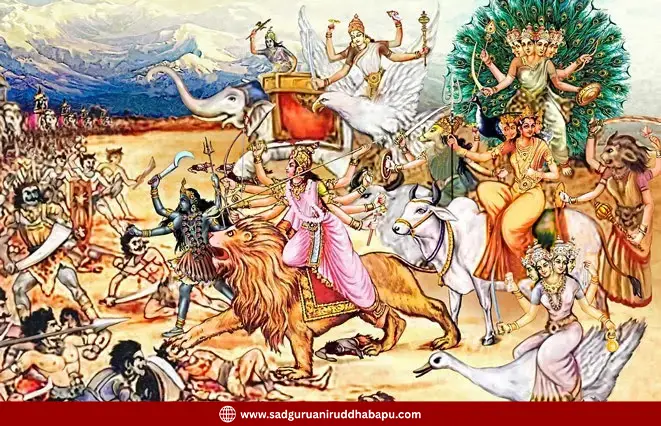
In Tulsipatra – 1395, Sadguru Shree Aniruddha Bapu writes:
All the Brahmarshis and Brahmavadinis, filled with love and reverence, began to chant the ‘Lalitashtak Stotra’ in the Samavedic manner. Along with that, the form of Lalitambika merged back into the form of the 'Manidweepnivasini’. The Adimata too became invisible once again and appeared as before in her two forms — Ashtadashabhuja Anasuya and Shreevidya.
Then Brahmavadini Lopamudra stepped forward and began reciting the mantra, “Kalaratrim Brahmastutam Vaishnavim Skandamataram.” With that, the seventh Navadurga, Kalaratri, manifested once again in her usual form, but now glowing with a gentle radiance.
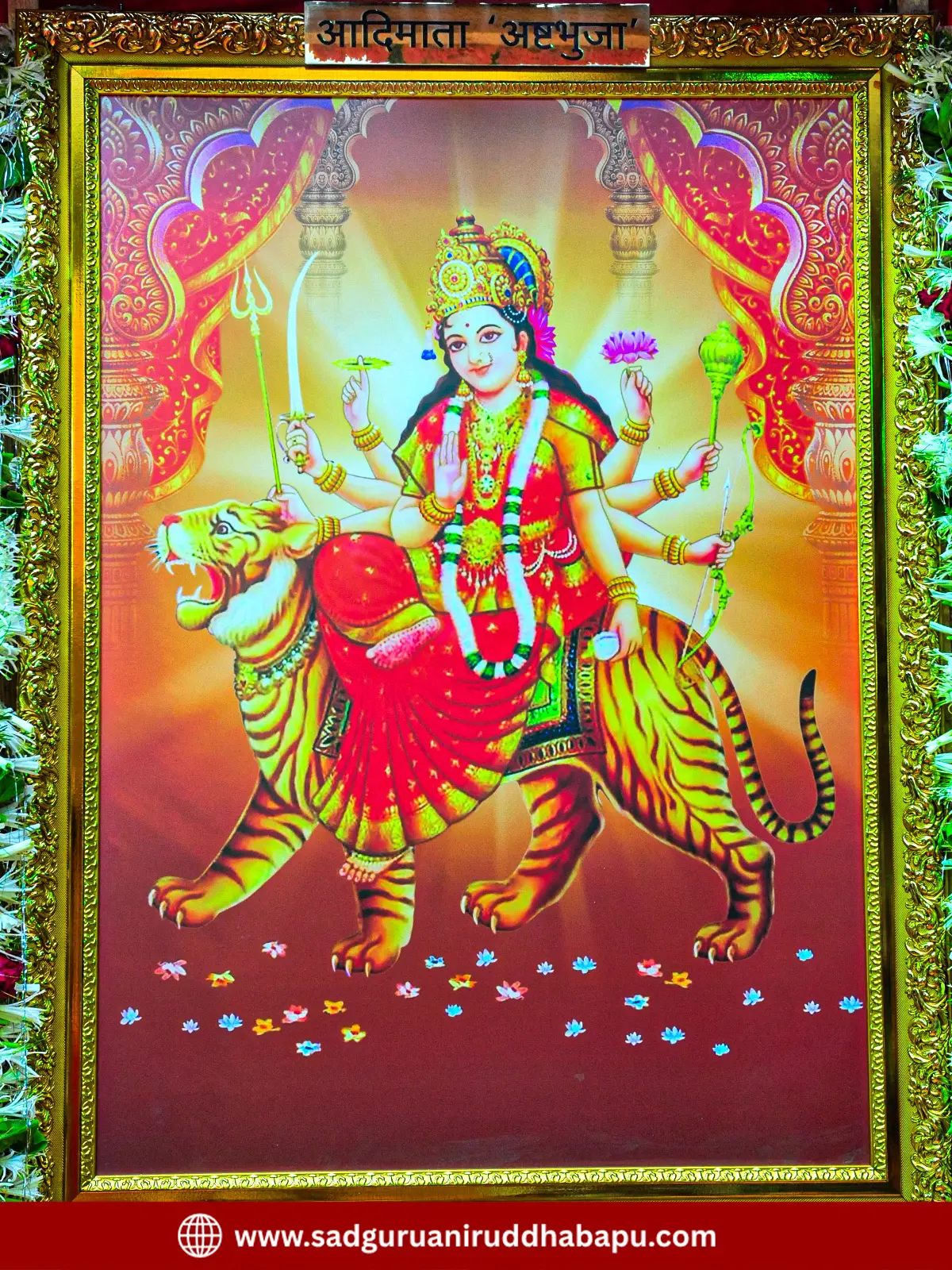
Lopamudra bowed before her and said, “Dear ones, on the thirteenth and fourteenth steps of the Shambhavi Vidya, it becomes absolutely necessary for every seeker to destroy all the enemies that obstruct his spiritual progress. If he does not, the demonic tendencies and impure-minded humans, opposed to purity itself, make the further journey of that seeker extremely difficult.
That is why a seeker or ascetic who has overcome the six foes of good life (Shadripu) must now act as a brave and valiant warrior. For this very reason, the seventh Navadurga, Kalaratri, remains ever vigilant.
Even Parvati, during the penance of her life, after passing through the stages of Skandamata and Katyayani, fought shoulder to shoulder along with Bhagwan Shiva and many times all alone, against thousands and thousands of demons, destroying every one of them. Her form that appeared on the battlefield was this very seventh Navadurga, Kalaratri, who is always ready to fight for the protection of her children.
O dear ones, look closely. Even on her ‘Chandratalwar’ (sword), there is an eye on each side of the blade. Whenever a true Shraddhavan progresses in his path of devotion, and someone tries to attack him—whether in worldly or spiritual life, the eyes of Goddess Kalaratri are fixed upon that person. At the exact right moment, she hurls her ‘Chandratalwar’ at that wicked being or demon without moving from her place.
The two eyes on her sword guide it perfectly. No matter where that enemy may hide, this sword pierces through all his barriers and defenses, bringing about his destruction for the protection of the Shraddhavans.
Now, look at the weapon with spikes in her hand. It has seven spikes. Of these, six spikes destroy, in all six planes of existence, the subtlest impurities and the influence of demons. In truth, the sixth spike has never yet been used, because no demon has ever entered the sixth plane. And in the seventh plane, it is impossible for demonic tendencies to enter at all.
Then what is the purpose of the seventh spike?
This seventh spike is the supreme instrument given by Goddess Kalaratri to a seeker of the Shambhavi Vidya at the thirteenth and fourteenth step. With it, the seeker can inscribe upon his inner being whatever he wishes — feelings, words, meditations, instances, experiences, stotras, mantras, or Namas.
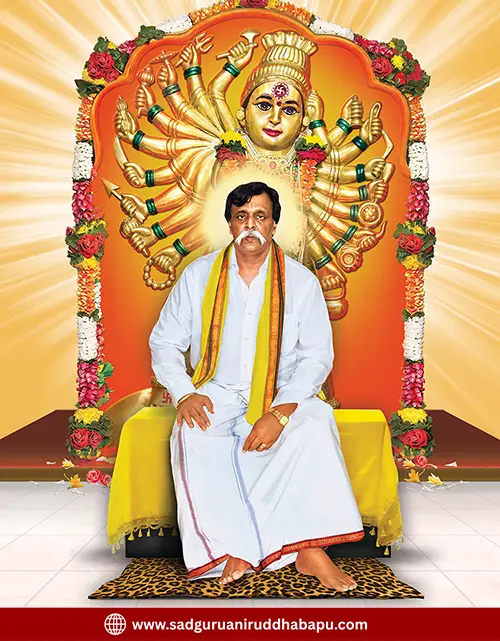
When a Shraddhavan receives this seventh spike, then Bhagwan Trivikram himself, after the devotee has completed his writing, grants him the mantra of the Shambhavi Vidya. At that moment, Goddess Kalaratri takes the form of Mahagauri and accepts that seeker as a student of the Shambhavi Vidya.
‘O Gautama and Ahalya, come forward. Welcome to you both. You have already learned everything till this point.’
All the Brahmarshis and Brahmavadinis, along with the others present, stood up and welcomed Gautama and Ahalya with love.
Then Lopamudra continued, “Moving from the fierce yet profoundly pure and loving form of Kalaratri to the next form, Mahagauri, is a journey from intense, blazing radiance to the most gentle, cooling light — in other words, the understanding and knowledge of the two poles of the universe.”
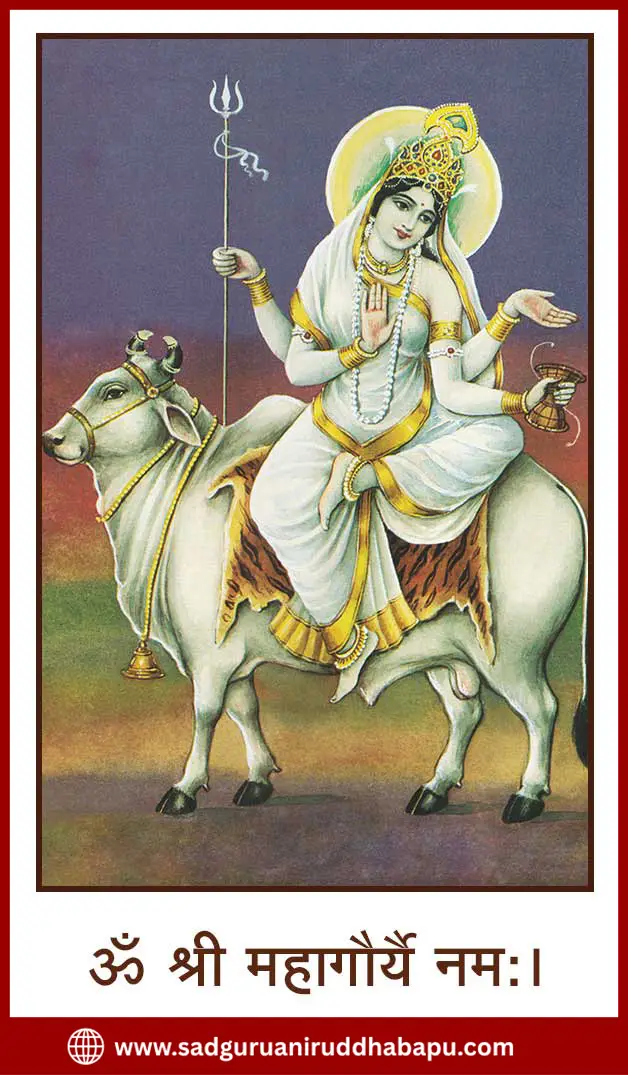
Now the seventh Navadurga, Kalaratri, slowly began to transform into the eighth Navadurga, Mahagauri.
Gautama and Ahalya praised Goddess Kalaratri and lovingly took her leave.
But Goddess Kalaratri placed her thumb-sized form within the heart of Sage Gautama.
